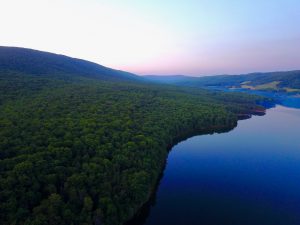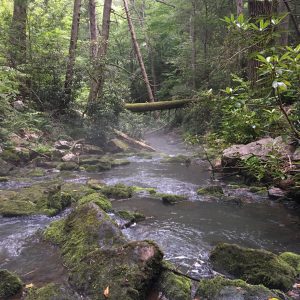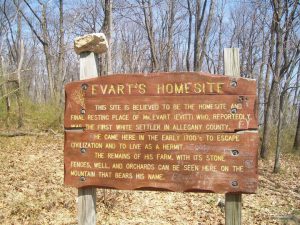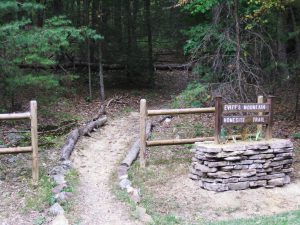Mr. Evart’s Mountain: Retracing the Steps of Allegany County’s Loneliest Settler

Evitt’s Mountain; by Richard Dos Santos
There’s not a lot left at Evart’s homesite, at the top of the mountain that bears the same name: scattered bits of foundation, a cluster of apple trees, an old stone well choked with blueberry bushes. But the things that drew Jacob Evart to the wilderness in the first place—the quiet, the solitude—endure. Up here, with only the birds and the clouds as companions, Evart lived a hermit’s life, removed from society and far from the woman who broke his heart.
Climbing Evitt’s Mountain—along the 2.4-mile Evitt’s Homesite Trail in Rocky Gap State Park—is still a challenge today. The trail ascends more than 1,200 feet and includes some steep and uneven terrain. But with the benefit of state park maintenance—not to mention your phone’s GPS—accessing Evart’s hideaway is considerably easier than it would have been for the man himself, who is still thought to be Allegany County’s first white settler.

Sites along the trail; by Ashley Stimpson
The trail begins not far from the north-west shores of Lake Habeeb. Within a quarter-mile, the path descends into a moody hemlock gorge, where tangles of rhododendron and mountain laurel cling to jagged rock faces and fallen timber. As you cross the tumbling Rocky Gap Run—a tributary of Evitt’s Creek—be sure to look up at the towering hemlock trees that guard the base of Evitt’s Mountain like a privacy fence, the arduous climb out of the canyon a deterrent to anyone who might have come looking for the recluse.
“Neither the allurements of civilized life, nor the dangers of the forest were sufficient to deter him,” John Thomas Scharf wrote of Evart in the 1968 publication “History of Western Maryland.” While much of Evart’s life is still a mystery, historians agree on a few key facts: at some point, local dialect transformed Evart into Evitt. He was English. And in 1730, after a particularly disastrous love affair with a woman who remains unknown, he fled some 60 miles from his home and deep into the mountains.
Far from the idyllic retreat they are today, the Allegheny Mountains in the early 18th century were largely uncharted, perilous territory, inhabited not only by wild animals, but Native American tribes, prepared to defend their land from encroaching settlement. Undaunted, Evart “fixed his habitation far in the wilderness, and on so rugged a spot,” that no one found it until long after his death.

Evart’s homesite sign; by Sarah Milbourne
About three-quarters of mile into the hike, you’ll begin to feel that ruggedness in your legs as the trail veers away from the whirring sounds of boat engines on the lake and up, up, up the wild hill. Soon, pausing to catch your breath, you may start to realize why no one ever found Evart, and you will understand just how alone he would have been on his mountain.
There are views to be had on this tough but gentle ascent, especially in winter. Check out the resort below and the mountains furrowed purple behind its five stories; keep an ear out for warblers and vireos cheering you on. Lore has it that Evart traveled down his mountain each morning, perhaps to hunt or forage, and back up again—without the benefit of the white blazes that guide visitors today.
Just when it seems the trail will never cease to creep upward, the homesite comes into view, marked plainly with a few spare fence posts. Plan to spend some time at Evart’s place, where a small clearing provides an ideal spot for a picnic or just a rest. It’s not difficult to imagine what the knoll looked like 300 years ago, when Evart admired it from his cabin. That home is all but gone now, save for a few shards of foundation still blooming from the fertile soil Evart once tilled, before he died—alone and of unknown causes—sometime prior to 1750.

Evitt’s Mountain Homesite Trail; by Sarah Milbourne
If endurance and daylight are on your side, continue your hike an additional mile to see a Mason-Dixon marker (erected in 1766, after Evart’s stay on the mountain) and a sweeping panorama of Pennsylvania’s Bedford Valley below.
The descent offers another chance to scramble through the hemlock gorge, or you can take the shortcut trail that will deliver you back to the main area of the park, sans scramble.
A five-mile round trip that allows hikers to span centuries, Evitt’s Homesite Trail provides unique insight into one of the most mysterious pioneers of western Maryland. The haunting solitude of the mountain makes it easy to understand its appeal to Jacob Evart, who, in his quest to fade quietly into anonymity, managed to ink his misspelled name into Maryland history books forever.
Article by Ashley Stimpson—freelance outdoors writer. Appears in Vol. 22, No. 2 of the Maryland Natural Resource magazine, spring 2019.


 1-888-373-7888
1-888-373-7888 233733
233733